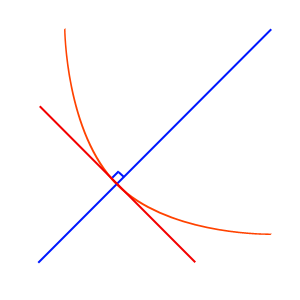Tangents and Normals
This article is only useful if you know what tangets are. Be able to find gradients of tangents and be able to form general formulas for tangents. This is just an expansion from Gradient of a Tangent to a curve and without any knowledge of tangents be ready for huge headaches.
You know that a tangent to a curve is a straight line which touches the curve at a certain point. Well…
The normal to a curve is the straight line perpendicular to the tangent at the same point as the tangent attachment to the curve. In the following illustration the normal to the curve is the blue line while the orange line is the tangent and the red line the curve.

If the gradient of the tangent is m
…then the gradient of the normal is -1/m
For instance;
if the gradient of a tangent is 4 then the gradient of the normal is -1/4
It is as simple as that, this is how you find the normal to the curve at a certain point but you first need to differentiate to find the gradient first.
In most cases when working with tangents and normals there will be a need to find the equations of the tangents and normals at a certain point. In the following examples we shall be exploring just that.
To find the equations of either the tangent of the normal we need to know the gradient of the curve and the point of the line then we use the following equation;
where m is the gradient and (x1, y1) is the point given.
Finding the equation of the tangent
In this section we shall look at how to find the equation of a tangent.
[IMAGE]
We can also see the tagent (which is the line touching the curve at that point)
[IMAGE]
We need to find the general formula that can be used to find the gradient at any point on the curve. We find this by using differentiation
To find the gradient at x = 1 we substitute the x value in the gradient formula 6x.
The gradient is a 6 at the position when x = 1.
To find the y value we use the x coordinate value by substituting it into the original curve equation;
Now we know the point on the curve at where the gradient is 6 is (1, 7).
From here we can use thelinear equation of a curve to form the tangent equation at that point;
Th equation of a tangent to the curve; y = 3x2 + 4 at the point where x = 1 is given by; y = 6x + 1.
Finding the equation of a normal
This is exactly the same except instead of using the tangent gradient we use the normal gradient value in the equation of a linear line y – y1 = m(x – x1)
We will need to differentiate the equation of the curve first. The differentiation will provide a formula to find the gradient of the curve at any point.
Once we have found the differentiation we will need to use it to find the gradient of the curve at the point where x = 3.
= 3
This gives us the gradient of the tangent at the point where x = 3, this is equal to3.
We have the gradient of the tagent, we can go further to use it to find the gradient of the normal at that point;
The normal gradient is -1/3.
We also need to find the value of y at the point where x is equl to 3. This is simple; we use the curve equation by substituting in the value of x.
So far we know that;
Now we can use the equation as y – y1 = m(x – x1)
The equation for the normal to the curve where x = 3 is 3y + x = 9
